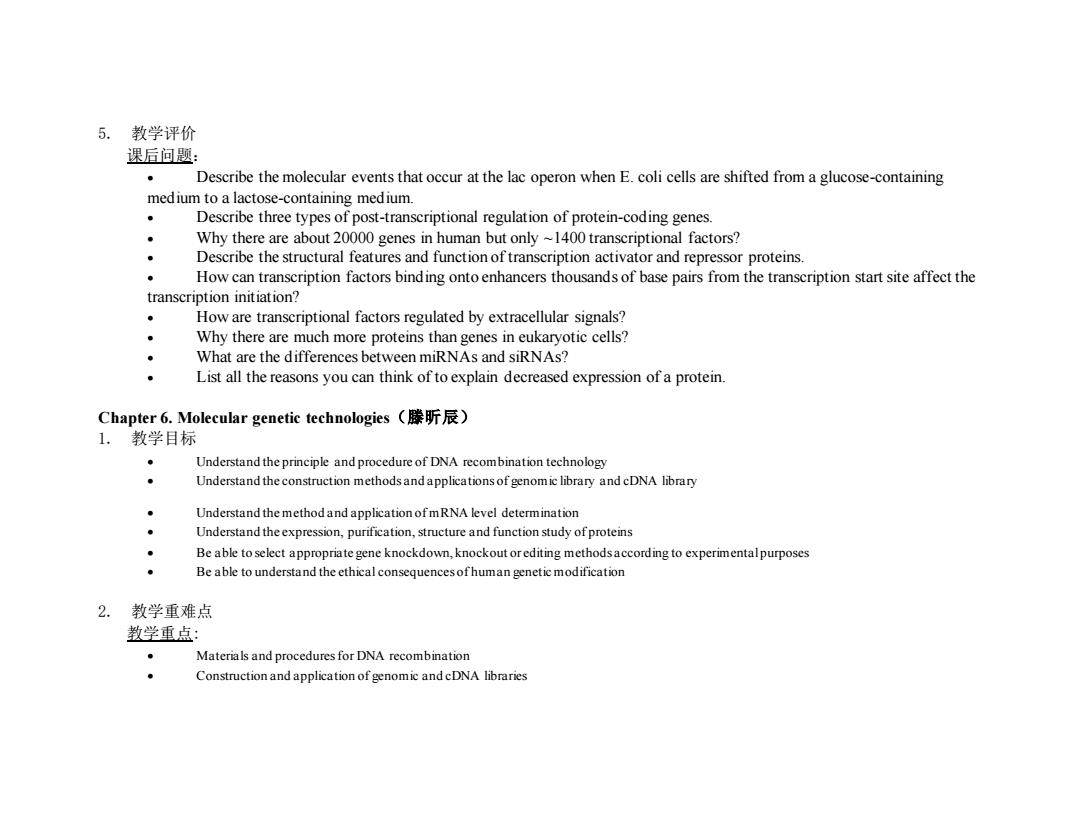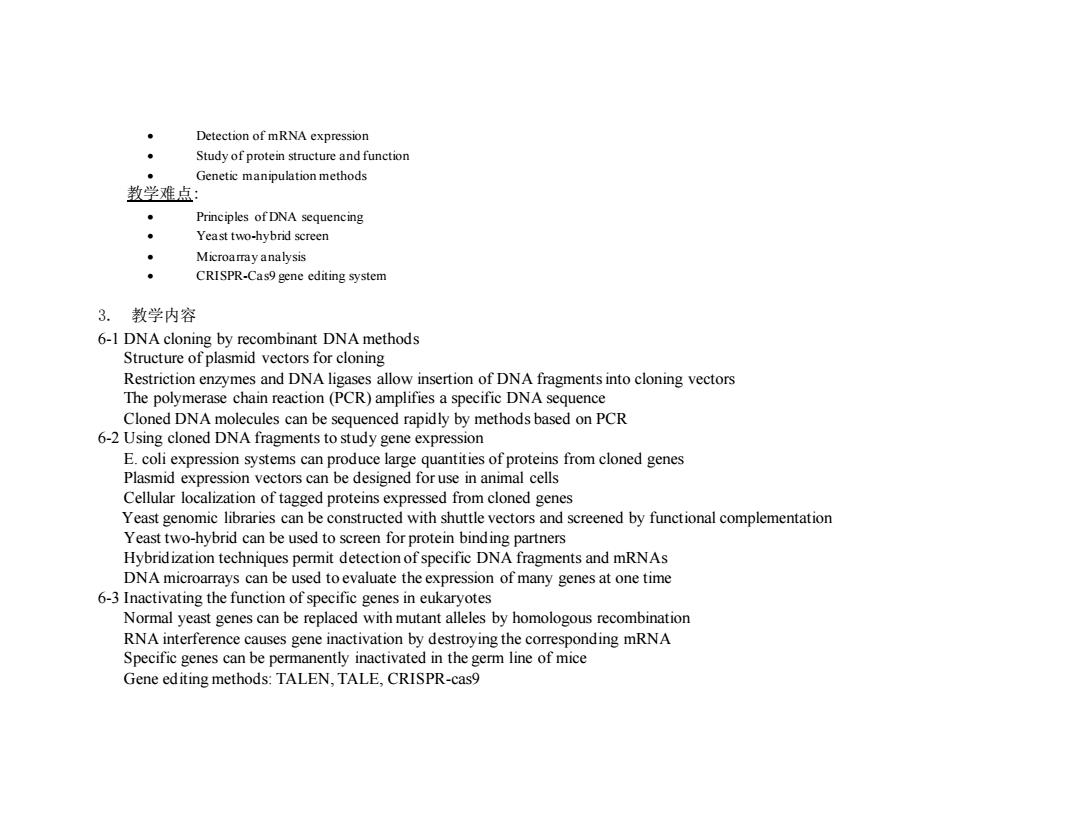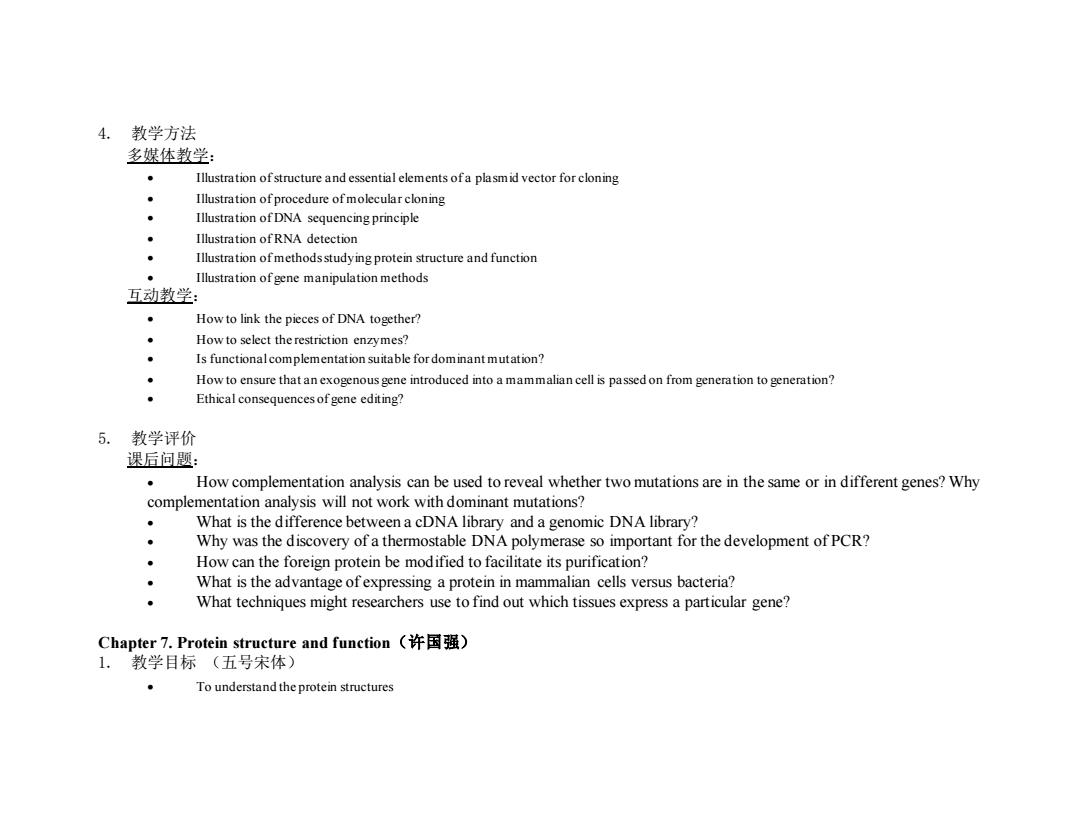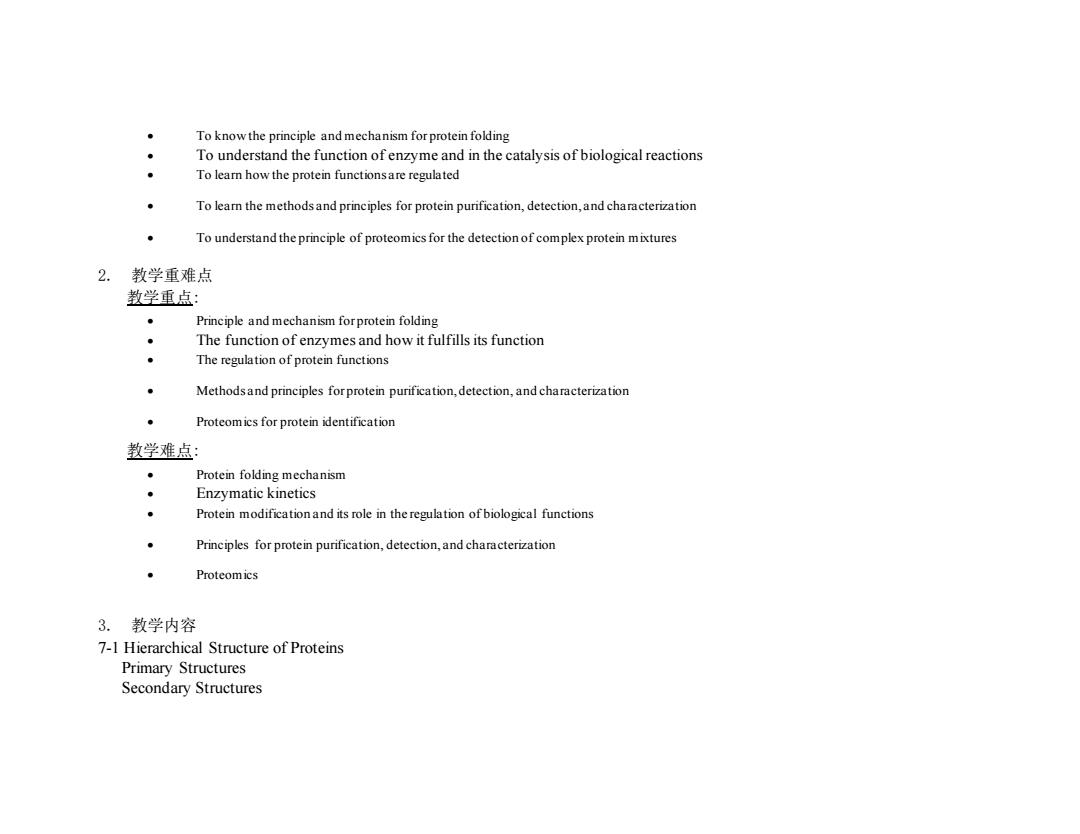
5.教学评价 课后问题: Describe the molecular events that occur at the lac operon when E.coli cells are shifted from a glucose-containing medium to a lactose-containing medium. Describe three types of post-transcriptional regulation of protein-coding genes. Why there are about 20000 genes in human but only ~1400 transcriptional factors? Describe the structural features and function of transcription activator and repressor proteins How can transcription factors bind ing onto enhancers thousands of base pairs from the transcription start site affect the transcription initiation? How are transcriptional factors regulated by extracellular signals? Why there are much more proteins than genes in eukaryotic cells? What are the differences between miRNAs and siRNAs? List all the reasons you can think of to explain decreased expression of a protein. Chapter6.Molecular genetic technologies(滕昕辰) 1.教学目标 Understand the principle and procedure of DNA recombination technology Understand the construction methods and applications of genomic library and cDNA library Understand the method and application ofmRNA level determination Understand the expression,purification,structure and function study of proteins Be able to select appropriate gene knockdown,knockout or editing methodsaccording to experimentalpurposes Be able to understand the ethical consequencesofhuman genetic modification 2. 教学重难点 教学重点: Materials and procedures for DNA recombination Construction and application of genomic and cDNA libraries
5. 教学评价 课后问题: • Describe the molecular events that occur at the lac operon when E. coli cells are shifted from a glucose-containing medium to a lactose-containing medium. • Describe three types of post-transcriptional regulation of protein-coding genes. • Why there are about 20000 genes in human but only ~1400 transcriptional factors? • Describe the structural features and function of transcription activator and repressor proteins. • How can transcription factors binding onto enhancers thousands of base pairs from the transcription start site affect the transcription initiation? • How are transcriptional factors regulated by extracellular signals? • Why there are much more proteins than genes in eukaryotic cells? • What are the differences between miRNAs and siRNAs? • List all the reasons you can think of to explain decreased expression of a protein. Chapter 6. Molecular genetic technologies(滕昕辰) 1. 教学目标 • Understand the principle and procedure of DNA recombination technology • Understand the construction methods and applications of genomic library and cDNA library • Understand the method and application of mRNA level determination • Understand the expression, purification, structure and function study of proteins • Be able to select appropriate gene knockdown, knockout or editing methods according to experimental purposes • Be able to understand the ethical consequences of human genetic modification 2. 教学重难点 教学重点: • Materials and procedures for DNA recombination • Construction and application of genomic and cDNA libraries

Detection of mRNA expression Study of protein structure and function Genetic manipulation methods 教学难点: Principles of DNA sequencing Yeast two-hybrid screen Microarray analysis ● CRISPR-Cas9 gene editing system 3.教学内容 6-1 DNA cloning by recombinant DNA methods Structure of plasmid vectors for cloning Restriction enzymes and DNA ligases allow insertion of DNA fragments into cloning vectors The polymerase chain reaction(PCR)amplifies a specific DNA sequence Cloned DNA molecules can be sequenced rapidly by methods based on PCR 6-2 Using cloned DNA fragments to study gene expression E.coli expression systems can produce large quantities of proteins from cloned genes Plasmid expression vectors can be designed for use in animal cells Cellular localization of tagged proteins expressed from cloned genes Yeast genomic libraries can be constructed with shuttle vectors and screened by functional complementation Yeast two-hybrid can be used to screen for protein binding partners Hybrid ization techniques permit detection of specific DNA fragments and mRNAs DNA microarrays can be used to evaluate the expression of many genes at one time 6-3 Inactivating the function of specific genes in eukaryotes Normal yeast genes can be replaced with mutant alleles by homologous recombination RNA interference causes gene inactivation by destroying the corresponding mRNA Specific genes can be permanently inactivated in the germ line of mice Gene editing methods:TALEN,TALE,CRISPR-cas9
• Detection of mRNA expression • Study of protein structure and function • Genetic manipulation methods 教学难点: • Principles of DNA sequencing • Yeast two-hybrid screen • Microarray analysis • CRISPR-Cas9 gene editing system 3. 教学内容 6-1 DNA cloning by recombinant DNA methods Structure of plasmid vectors for cloning Restriction enzymes and DNA ligases allow insertion of DNA fragments into cloning vectors The polymerase chain reaction (PCR) amplifies a specific DNA sequence Cloned DNA molecules can be sequenced rapidly by methods based on PCR 6-2 Using cloned DNA fragments to study gene expression E. coli expression systems can produce large quantities of proteins from cloned genes Plasmid expression vectors can be designed for use in animal cells Cellular localization of tagged proteins expressed from cloned genes Yeast genomic libraries can be constructed with shuttle vectors and screened by functional complementation Yeast two-hybrid can be used to screen for protein binding partners Hybridization techniques permit detection of specific DNA fragments and mRNAs DNA microarrays can be used to evaluate the expression of many genes at one time 6-3 Inactivating the function of specific genes in eukaryotes Normal yeast genes can be replaced with mutant alleles by homologous recombination RNA interference causes gene inactivation by destroying the corresponding mRNA Specific genes can be permanently inactivated in the germ line of mice Gene editing methods: TALEN, TALE, CRISPR-cas9

4.教学方法 多媒体教学: Illustration ofstructure and essential elements ofa plasmid vector for cloning Illustration of procedure of molecular cloning Illustration of DNA sequencing principle Illustration ofRNA detection Illustration ofmethods studying protein structure and function Illustration of gene manipulation methods 互动教学: How to link the pieces of DNA together? How to select the restriction enzymes? Is functional complementation suitable for dominant mutation? How to ensure that an exogenous gene introduced into a mammalian cell is passed on from generation to generation? Ethical consequences of gene editing? 5. 教学评价 课后问题: How complementation analysis can be used to reveal whether two mutations are in the same or in different genes?Why complementation analysis will not work with dominant mutations? What is the difference between a cDNA library and a genomic DNA library? Why was the discovery of a thermostable DNA polymerase so important for the development of PCR? How can the foreign protein be modified to facilitate its purification? What is the advantage of expressing a protein in mammalian cells versus bacteria? What techniques might researchers use to find out which tissues express a particular gene? Chapter7.Protein structure and function(许国强) 1.教学目标(五号宋体) To understand the protein structures
4. 教学方法 多媒体教学: • Illustration of structure and essential elements of a plasmid vector for cloning • Illustration of procedure of molecular cloning • Illustration of DNA sequencing principle • Illustration of RNA detection • Illustration of methods studying protein structure and function • Illustration of gene manipulation methods 互动教学: • How to link the pieces of DNA together? • How to select the restriction enzymes? • Is functional complementation suitable for dominant mutation? • How to ensure that an exogenous gene introduced into a mammalian cell is passed on from generation to generation? • Ethical consequences of gene editing? 5. 教学评价 课后问题: • How complementation analysis can be used to reveal whether two mutations are in the same or in different genes? Why complementation analysis will not work with dominant mutations? • What is the difference between a cDNA library and a genomic DNA library? • Why was the discovery of a thermostable DNA polymerase so important for the development of PCR? • How can the foreign protein be modified to facilitate its purification? • What is the advantage of expressing a protein in mammalian cells versus bacteria? • What techniques might researchers use to find out which tissues express a particular gene? Chapter 7. Protein structure and function(许国强) 1. 教学目标 (五号宋体) • To understand the protein structures

To know the principle and mechanism for protein folding To understand the function of enzyme and in the catalysis of biological reactions To learn how the protein functionsare regulated To learn the methods and principles for protein purification,detection,and characterization To understand the principle of proteomics for the detection of complex protein mixtures 2.教学重难点 教学重点: Principle and mechanism for protein folding The function of enzymes and how it fulfills its function The regulation of protein functions ● Methods and principles for protein purification,detection,and characterization Proteomics for protein identification 教学难点 Protein folding mechanism Enzymatic kinetics Protein modification and its role in the regulation of biological functions Principles for protein purification,detection,and characterization Proteomics 3.教学内容 7-1 Hierarchical Structure of Proteins Primary Structures Secondary Structures
• To know the principle and mechanism for protein folding • To understand the function of enzyme and in the catalysis of biological reactions • To learn how the protein functions are regulated • To learn the methods and principles for protein purification, detection, and characterization • To understand the principle of proteomics for the detection of complex protein mixtures 2. 教学重难点 教学重点: • Principle and mechanism for protein folding • The function of enzymes and how it fulfills its function • The regulation of protein functions • Methods and principles for protein purification, detection, and characterization • Proteomics for protein identification 教学难点: • Protein folding mechanism • Enzymatic kinetics • Protein modification and its role in the regulation of biological functions • Principles for protein purification, detection, and characterization • Proteomics 3. 教学内容 7-1 Hierarchical Structure of Proteins Primary Structures Secondary Structures